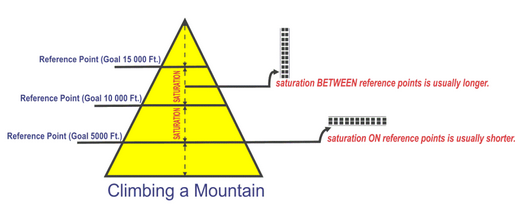Know When to Move On in Life – The Saturation Principle Explained
Lesson 26 Module 3
(Click 3 dots to download MP3)
Sign up below to my Personal Growth newsletter.
The SATURATION PRINCIPLE is a very important principle to understand because it relates to how you move on in life. Think of SATURATION as SATISFACTION because that is how it feels when you are moving through life.
To better understand how the SATURATION PRINCIPLE works, we can use the analogy of a mountain which YOU want to climb.

As a climber, you need to have goals about which elevation you want to reach in order to break up the journey into pieces. Well, the goals actually symbolize your REAL LIFE GOALS that you need to accomplish. Let say your goals are:
Goal #1 - 5000 Ft. (stop 1) - reference point 1
Goal #2 - 10000 Ft. (stop 2) - reference point 2
Goal #3 - 15000 Ft. (final destination) - reference point 3
In this principle there are TWO TYPES of SATURATION, which are 1)Saturation Between Reference Points 2)Saturation On Reference Points.
1) Saturation Between Reference Points - this saturation (satisfaction) that you are experiencing usually takes longer to complete until you arrived at your next goal (reference point). This saturation can take anywhere from 1-30 years to finish, it really depends what you are trying to accomplish. However, it could also be shorter like 6 months if the goal you have simply takes less time to accomplish.
2) Saturation On Reference Points - this saturation (satisfaction) is usually shorter in total duration which can last 3 months - 2 years depending on the goal that you have achieved. The reason time-frame varies is because you may be unsure of what to execute next, which means you would be standing/saturating yourself from the recently achieved life goal.
What you need to understand is that these two different types of saturation will always alternate with each other, since that is just how the process of moving through life works. You would always have:
1. Shorter time frame = SATURATION ON REFERENCE POINTS (previous achieved goal)
2. Longer time frame = SATURATION BETWEEN REFERENCE POINTS ( future goal)
3. Shorter time frame = SATURATION ON REFERENCE POINTS (future goal becomes previous achieved goal)
4. Longer time frame = SATURATION BETWEEN REFERENCE POINTS ( future goal)
5. Shorter time frame = SATURATION ON REFERENCE POINTS (future goal becomes previous achieved goal)
This continues on and on and on...
Every time you reach your GOAL (reference point), your brain will release positive emotions (neuropeptides) since you have achieved what you wanted. Positive emotion will only be generated if the expected mental outcome fits your reality. However, if you don't get what you want then you would produce a negative emotion or no emotion at all.
NOTE:
You may actually achieve your goal but then either right away or within 1-7 days you may feel sad or even depressed. Why would this happen? Well, when you were on you path everyday executing to achieve the goal, your brain was actually manufacturing more DOPAMINE + SEROTONIN and because of this you felt better.
What actually has happened is that your brain does not have anything of significance to focus on after the goal have been accomplished. Therefore, you have actually decreased the amount of DOPAMINE and because of this you feel down (of course, that is assuming you have no other health conditions).
How do you fix this? You need to find yourself a new goal that is important to you and start executing it. This is when DOPAMINE will start to rise again and you will start feeling happier.
If you want to contact me, you can do so below.

